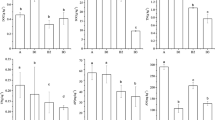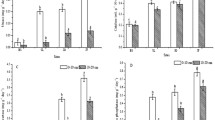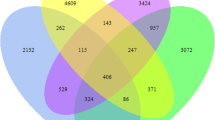Abstract
Purpose
We evaluated the role of water levels and plant-associated effects on the composition of bacterial communities and the soil organic matter (SOM) composition in wetland ecosystem.
Materials and methods
Soil (0–15 cm) associated with Phragmites communis, Triarrhena lutarioriparia, Carex cinerascens, and Zizania latifolia was sampled in different water levels (as proxied by sampling time) to analyze soil SOM composition via diffuse reflectance infrared Fourier transform spectroscopy in the mid-infrared range analysis and to analyze soil bacterial communities by high-throughput 16S rRNA gene sequencing.
Results and discussion
Soil dominant SOM composition (1623–1635 cm−1 and 3444–2697 cm−1) were obviously influenced by water levels not plant species (p < 0.05). Proteobacteria, Chloroflexi, Acidobacteria, and Firmicutes were the most abundant phyla and exhibited significantly different distributions across the soils with Z. latifolia, P. communis, T. lutarioriparia, and C. cinerascens communities and the non-plant flat mud soil (p < 0.05). Redundancy analysis and variation partitioning analysis indicated that the Wc, active organic carbon, TCstem, Temsoil, and water level significantly influenced the dominant soil bacterial taxonomic composition, while the soil bacteria may influence the SOM composition.
Conclusions
These findings suggested that soil SOM composition and bacterial communities were strongly affected by plant species and water levels. This study provides an in-depth insight into how specific SOM components related to the different distributions of the specific bacterial taxonomic groups that are responsible for key ecological functions in wetland ecosystem soils.






Similar content being viewed by others
Data Availability
All data generated or analyzed during this study are included in this manuscript.
References
Aanderud ZT, Jones SE, Fierer N, Lennon JT (2015) Resuscitation of the rare biosphere contributes to pulses of ecosystem activity. Front Microbiol 6:24. https://doi.org/10.3389/fmicb.2015.00024
Błońska E, Piaszczyk WM, Staszel K, Lasota J (2021) Enzymatic activity of soils and soil organic matter stabilization as an effect of components released from the decomposition of litter. Appl Soil Ecol 157:103723. https://doi.org/10.1016/j.apsoil.2020.103723
Banerjee S, Kirkby CA, Schmutter D, Bissett A, Kirkegaard JA, Richardson AE (2016) Network analysis reveals functional redundancy and keystone taxa amongst bacterial and fungal communities during organic matter decomposition in an arable soil. Soil Biol Biochem 97:188–198. https://doi.org/10.1016/j.soilbio.2016.03.017
Bar-On YM, Phillips R, Milo R (2018) The biomass distribution on Earth. Proc Natl Acad Sci U S A 115:6506–6511. https://doi.org/10.1073/pnas.1711842115
Bernier MH, Levy GJ, Fine P, Borisover M (2013) Organic matter composition in soils irrigated with treated wastewater: FT-IR spectroscopic analysis of bulk soil samples. Geoderma 209–210:233–240. https://doi.org/10.1016/j.geoderma.2013.06.017
Calderón FJ, Mikha MM, Vigil MF, Nielsen DC, Benjamin JG, Reeves JB (2011a) Diffuse-reflectance mid-infrared spectral properties of soils under alternative crop rotations in a semi-arid climate. Commun Soil Sci Plan 42:2143–2159. https://doi.org/10.1080/00103624.2011.596243
Calderón FJ, Reeves JB, Collins HP, Paul EA (2011b) Chemical differences in soil organic matter fractions determined by diffuse-reflectance mid-infrared spectroscopy. Soil Sci Soc Am J 75:568–579. https://doi.org/10.2136/sssaj2009.0375
Cao XB, Lin D, Cai L, Jiang YM, Zhu D (2017) Effects of different vegetation communities on soil carbon fraction, RubisCO activity and cbbl genes in Nanjishan wetland of Poyang Lake. Acta Pedologica Sin 54:1269–1279. https://dx.doi.org/10.11766/trxb201702200543
Chen MH, He SY, Li JQ, Hu WJ, Ma YT, Wu L, Ge G (2019) Co-occurrence patterns between bacterial and fungal communities in response to a vegetation gradient in a freshwater wetland. Can J Microbiol 65:722–737. https://doi.org/10.1139/cjm-2019-0147
Chen X, Yang XD, Dong XH, Liu Q (2010) Nutrient dynamics linked to hydrological condition and anthropogenic nutrient loading in Chaohu Lake (southeast China). Hydrobiologia 661:223–234. https://doi.org/10.1007/s10750-010-0526-y
Cheng L, Zhang NF, Yuan MT, Xiao J, Qin YJ, Deng Y, Tu QC, Xue K, Nostrand JDV, Wu LY, He ZL, Zhou XH, Leigh MB, Konstantinidis KT, Schuur EAG, Luo YQ, Tiedje JM, Zhou JZ (2017) Warming enhances old organic carbon decomposition through altering functional microbial communities. ISME J 11:1825–1835. https://doi.org/10.1038/ismej.2017.48
Colombani N, Mastrocicco M, Castaldelli G, Aravena R (2019) Contrasting biogeochemical processes revealed by stable isotopes of H2O, N, C and S in shallow aquifers underlying agricultural lowlands. Sci Total Environ 691:1282–1296. https://doi.org/10.1016/j.scitotenv.2019.07.238
Coolen MJL, van de Giessen J, Zhu EY, Wuchter C (2011) Bioavailability of soil organic matter and microbial community dynamics upon permafrost thaw. Environ Microbiol 13:2299–2314. https://doi.org/10.1111/j.1462-2920.2011.02489.x
Davinic M, Fultz LM, Acosta-Martinez V, Calderón FJ, Cox SB, Dowd SE, Allen VG, Zak JC, Moore-Kucera J (2012) Pyrosequencing and mid-infrared spectroscopy reveal distinct aggregate stratification of soil bacterial communities and organic matter composition. Soil Biol Biochem 46:63–72. https://doi.org/10.1016/j.soilbio.2011.11.012
Dhillon GS, Gillespie A, Peak D, Van Rees KCJ (2017) Spectroscopic investigation of soil organic matter composition for shelterbelt agroforestry systems. Geoderma 298:1–13. https://doi.org/10.1016/j.geoderma.2017.03.016
Dohnalkova AC, Tfaily MM, Smith AP, Chu RK, Crump AR, Brislawn CJ, Varga T, Shi ZQ, Thomashow LS, Harsh JB, Keller KC (2017) Molecular and microscopic insights into the formation of soil organic matter in a red pine rhizosphere. Soils 1:4. http://dx.doi.org/10.3390/soils1010004
Du W, Li ZQ, Zhang ZX, Jin Q, Chen X, Jiang SS (2017) Composition and Biomass of Aquatic Vegetation in the Poyang Lake, China. Scientifica 2017:1–10. https://doi.org/10.1155/2017/8742480
Eskelinen A, Stark S, Männistö M (2009) Links between plant community composition, soil organic matter quality and microbial communities in contrasting tundra habitats. Oecologia 161:113–123. https://doi.org/10.1007/s00442-009-1362-5
Fierer N, Bradford MA, Jackson RB (2007) Toward an ecological classification of soil bacteria. Ecology 88:1354–1364. https://doi.org/10.1890/05-1839
Fultz LM, Moore-Kucera J, Calderón F, Acosta-Martínez V (2014) Using fourier-transform mid-infrared spectroscopy to distinguish soil organic matter composition dynamics in aggregate fractions of two agroecosystems. Soil Sci Soc Am J 78:1940. https://doi.org/10.2136/sssaj2014.04.0161
Guan SF, Lang Q, Zhang B (1987) Biomass of macrophytes of the Poyang Lake with suggestions of its rational exploitation. Acta Hydrobiol Sin 11:219–227
Han XX, Chen XL, Feng L (2015) Four decades of winter wetland changes in Poyang Lake based on Landsat observations between 1973 and 2013. Remote Sens Environ 156:426–437. https://doi.org/10.1016/j.rse.2014.10.003
Jiang YM, Chen CR, Xu ZH, Liu YQ (2012) Effects of single and mixed species forest ecosystems on diversity and function of soil microbial community in subtropical China. J Soil Sediment 12:228–240. https://doi.org/10.1007/s11368-011-0442-4
Jiang YM, Lin D, Guan XJ, Wang JF, Cao GP, Zhu D, Peng CR (2017) Effect of herbicide used with years (8 + 1) on soil enzymic activity and microbial population diversity. J Soil Sediment 17:2490–2499. https://doi.org/10.1007/s11368-017-1672-x
Jiang YM, Zhang C, Huang XL, Ni CY, Wang JF, Song PF, Zhang ZB (2016) Effect of heavy metals in the sediment of Poyang Lake estuary on microbial communities structure base on Mi-seq sequencing. China Environ Sci 36:3475–3486. https://doi.org/10.3969/j.issn.1000-6923.2016.11.034
Jin X, Ma YT, Kong ZY, Kou WB, Wu L (2017) The variation of sediment bacterial community in response to anthropogenic disturbances of Poyang Lake, China. Wetlands39:63-73. https://dx.doi.org/10.1007/s13157-017-0909-1
Kallenbach CM, Frey SD, Grandy AS (2016) Direct evidence for microbial-derived soil organic matter formation and its ecophysiological controls. Nat Commun 7:13630. https://doi.org/10.1038/ncomms13630
Li J, Nie M, Pendall E (2020) Soil physico-chemical properties are more important than microbial diversity and enzyme activity in controlling carbon and nitrogen stocks near Sydney. Australia Geoderma 366:114201. https://doi.org/10.1016/j.geoderma.2020.114201
Liu FP, Xu GQ, Liu QC, Li JQ, Kou WB, Wu L (2015) Variation of structure of bacterial communities in soils with typical plant communitsies in Nanjishan wetlands. Wetland Sci 13:444–450. https://dx.doi.org/10.13248/j.cnki.wetlandsci.2015.04.009
Liu Y, Ren Z, Qu XD, Zhang M, Yu Y, Zhang YH, Peng WQ (2020) Microbial community structure and functional properties in permanently and seasonally flooded areas in Poyang Lake Sci Rep 10. https://doi.org/10.1038/s41598-020-61569-z
Lu PK (2000) Analytical methods of soil and agro-chemistry. China Agricultural Science and Technology Press, Beijing, pp 27–65
Luo M, Huang JF, Zhu WF, Tong C (2019) Impacts of increasing salinity and inundation on rates and pathways of organic carbon mineralization in tidal wetlands: a review. Hydrobiologia 827:31–49. https://doi.org/10.1007/s10750-017-3416-8
Luo M, Liu YX, Huang JF, Xiao LL, Zhu WF, Duan X, Tong C (2018) Rhizosphere processes induce changes in dissimilatory iron reduction in a tidal marsh soil: a rhizobox study. Plant Soil 433:83–100. https://doi.org/10.1007/s11104-018-3827-y
Luo XS, Cang L, Hao XZ, Li LZ, Zhou DM (2007) In-situ sampling of soil solution and determination of dissolved organic carbon (DOC) with UV absorption method (UVA254). Soil 39:943–947. https://doi.org/10.3321/j.issn:0253-9829.2007.06.020
Matamala R, Jastrow JD, Calderón FJ, Chao L, Fan ZS, Michaelson GJ, Ping CL (2019) Predicting the decomposability of arctic tundra soil organic matter with mid infrared spectroscopy. Soil Biol Biochem 129:1–12. https://doi.org/10.1016/j.soilbio.2018.10.014
Mirzaeitalarposhti R, Demyan MS, Rasche F, Cadisch G, Müller T (2016) Overcoming carbonate interference on labile soil organic matter peaks for midDRIFTS analysis. Soil Biol Biochem 99:150–157. https://doi.org/10.1016/j.soilbio.2016.05.010
Negassa W, Acksel A, Eckhardt KU, Regier T, Leinweber P (2019) Soil organic matter characteristics in drained and rewetted peatlands of northern Germany: chemical and spectroscopic analyses. Geoderma 353:468–481. https://doi.org/10.1016/j.geoderma.2019.07.002
Parikh SJ, Goyne KW, Margenot AJ, Mukome FND, Calderón FJ (2014) Soil chemical insights provided through vibrational spectroscopy. Adv Agron 126:1–148. https://doi.org/10.1016/b978-0-12-800132-5.00001-8
Parolo ME, Savini MC, Loewy RM (2017) Characterization of soil organic matter by FT-IR spectroscopy and its relationship with chlorpyrifos sorption. J Environ Manage 196:316–322. https://doi.org/10.1016/j.jenvman.2017.03.018
Peng YH, Jian YX, Li RD (2003) Community diversity of aquatic plants in the lakes of Poyang plain district of China. J Cent South Forestry Univ 23:22–27. https://doi.org/10.3969/j.issn.1673-923X.2003.04.014
Rulmont A, Cahay R, Liegeois-Duyckaerts M, Tarte P (1991) Vibrational spectroscopy of phosphates-some general correlations between structure and spectra. Eur J Sol State Inor 28:207–219
Seddaiu G, Porcu G, Ledda L, Roggero PP, Agnelli A, Corti G (2013) Soil organic matter content and composition as influenced by soil management in a semi-arid Mediterranean agro-silvo-pastoral system. Agric Ecosyst Environ 167:1–11. https://doi.org/10.1016/j.agee.2013.01.002
Sharma P, Laor Y, Raviv M, Medina S, Saadi I, Krasnovsky A, Vager M, Levy GJ, Bar-Tal A, Borisover M (2017) Compositional characteristics of organic matter and its water-extractable components across a profile of organically managed soil. Geoderma 286:73–82. https://doi.org/10.1016/j.geoderma.2016.10.014
Shen RC, Lan ZC, Rinklebe J, Nie M, Hu QW, Yan ZF, Fang CM, Jin BS, Chen JK (2021) Flooding variations affect soil bacterial communities at the spatial and inter-annual scales. Sci Total Environ 759:143471. https://doi.org/10.1016/j.scitotenv.2020.143471
Sheng P, Yu YZ, Zhang GH, Huang JL, He L, Ding JN (2016) Bacterial diversity and distribution in seven different estuarine sediments of Poyang Lake. China Environ Earth Sci 75:479. https://doi.org/10.1007/s12665-016-5346-6
Singer E, Bushnell B, Coleman-Derr D, Bowman B, Bowers RM, Levy A, Gies EA, Cheng JF, Copeland A, Klenk HP, Hallam SJ, Hugenholtz P, Tringe SG, Woyke T (2016) High-resolution phylogenetic microbial community profiling. ISME J 10:2020–2032. https://doi.org/10.1038/ismej.2015.249
Stepanauskas R, Moran MA, Bergamaschi BA, Hollibaugh JT (2003) Covariance of bacterioplankton composition and environmental variables in a temperate delta system. Aquat Microb Ecol 31:85–98. https://doi.org/10.3354/ame031085
Tian J, Lou YL, Gao Y, Fang HJ, Liu ST, Xu MG, Blagodatskaya E, Kuzyakov Y (2017) Response of soil organic matter fractions and composition of microbial community to long-term organic and mineral fertilization. Biol Fert Soils 53:523–532. https://doi.org/10.1007/s00374-017-1189-x
Vance ED, Brookes PC, Jenkinson DS (1987) An extraction method for measuring soil microbial biomass C. Soil Biol Biochem 19:703–707. https://doi.org/10.1016/0038-0717(87)90052-6
Wang HY, Nie Y, Butterly CR, Wang L, Chen QH, Tian W, Song BB, Xi YG, Wang Y (2017a) Fertilization alters microbial community composition and functional patterns by changing the chemical nature of soil organic carbon: A field study in a Halosol. Geoderma 292:17–24. https://doi.org/10.1016/j.geoderma.2017.01.006
Wang P, Chen B, Zhang H (2017b) High throughput sequencing analysis of bacterial communities in soils of a typical Poyang Lake wetland. Acta Ecol Sin 37:1650–1658. https://doi.org/10.5846/stxb201510052000
Wang WJ, Zhou W, Wang HM, Ji CP, Han SJ (2016a) Organic carbon and nitrogen dynamics in different soil fractions between broad-leaved Korean pine forests and aspen–birch forests in northeastern China. J Soil Sediment 17:2257–2273. https://doi.org/10.1007/s11368-016-1438-x
Wang XL, Xu LG, Wan RR (2016b) Comparison on soil organic carbon within two typical wetland areas along the vegetation gradient of Poyang Lake, China. Hydrol Res 47:261–277. https://doi.org/10.2166/nh.2016.218
Wang XL, Xu LG, Wan RR, Chen YW (2016c) Seasonal variations of soil microbial biomass within two typical wetland areas along the vegetation gradient of Poyang Lake, China. CATENA 137:483–493. https://doi.org/10.1016/j.catena.2015.10.020
Whitman WB, Coleman DC, Wiebe WJ (1998) Prokaryotes: The unseen majority. Proc Natl Acad Sci U S A 95:6578–6583. https://doi.org/10.1073/pnas.95.12.6578
Wu JS, Joergensen RG, Pommerening B, Chaussod R, Brookes PC (1990) Measurement of soil microbial biomass C by fumigation-extraction: An automated procedure. Soil Biol Biochem 20:1167–1169. https://doi.org/10.1016/0038-0717(90)90046-3
Wu XH, Ge TD, Yuan HZ, Zhou P, Chen XB, Chen S, Brookes P, Wu JS (2014) Evaluation of an optimal extraction method for measuring d-ribulose-1,5-bisphosphate carboxylase/oxygenase (RubisCO) in agricultural soils and its association with soil microbial CO2 assimilation. Pedobiologia 57:277–284. https://doi.org/10.1016/j.pedobi.2014.06.002
Xiao W, Feng SZ, Liu ZF, Su YR, Zhang Y, He XY (2017a) Interactions of soil particulate organic matter chemistry and microbial community composition mediating carbon mineralization in karst soils. Soil Biol Biochem 107:85–93. https://doi.org/10.1016/j.soilbio.2016.12.025
Xiao LL, Liu FH, Liu JC, Li JJ, Zhang YC, Yu F, Wang OM (2018) Nano-Fe3O4 particles accelerating electromethanogenesis on an hour-long timescale in wetland soil. Environ Sci Nano 5:436–445. https://doi.org/10.1039/C7EN00577
Xiao LL, Xie BH, Liu JC, Zhang HX, Han GX, Wang OM, Liu FH (2017b) Stimulation of long-term ammonium nitrogen deposition on methanogenesis by methanocellaceae in a coastal wetland. Sci Total Environ 595:337–343. https://doi.org/10.1016/j.scitotenv.2017.03.279
Xiao LL, Wei WC, Luo M, Xu HD, Feng DW, Yu JF, Huang JF, Liu FH (2019) A potential contribution of a Fe(iii)-rich red clay horizon to methane release: biogenetic magnetite-mediated methanogenesis. CATENA 181:104081. https://doi.org/10.1016/j.catena.2019.104081
Xiao LL, Zheng SL, Lichtfouse E, Luo M, Tan Y, Liu FH (2020) Carbon nanotubes accelerate acetoclastic methanogenesis: From pure cultures to anaerobic soils. Soil Biol Biochem 150:107938. https://doi.org/10.1016/j.soilbio.2020.107938
Yuan HZ, Ge TD, Zou SY, Wu XH, Liu SL, Zhou P, Chen XJ, Brookes P, Wu JS (2012) Effect of land use on the abundance and diversity of autotrophic bacteria as measured by ribulose-1,5-biphosphate carboxylase/oxygenase (RubisCO) large subunit gene abundance in soils. Biol Fert Soils 49:609–616. https://doi.org/10.1007/s00374-012-0750-x
Zhang LL, Yin JX, Jiang YZ, Wang H (2012) Relationship between the hydrological conditions and the distribution of vegetation communities within the Poyang Lake National Nature Reserve, China. Ecol Inform 11:65–75. https://doi.org/10.1016/j.ecoinf.2012.05.006
Zhang Y, Wang X, Hu M, Li PF (2015a) Effect of hydraulic retention time (HRT) on the biodegradation of trichloroethylene wastewater and anaerobic bacterial community in the UASB reactor. Appl Microbiol Biotechnol 99:1977–1987. https://doi.org/10.1007/s00253-014-6096-6
Zhang ZX, Chen X, Xu CY, Hong Y, Hardy J, Sun ZH (2015b) Examining the influence of river–lake interaction on the drought and water resources in the Poyang Lake basin. J Hydrol 522:510–521. https://doi.org/10.1016/j.jhydrol.2015.01.008
Zeng SL, Lai GY, Yang T (2019) Relationship between water level and area based on water fluctuating in Poyang lake. J Hydrol 39:46–51
Funding
This study was supported by the Natural Science Foundation of China (NSFC, 31760161) and the Natural Science Foundation for the Jiangxi Province of China (20202BABL203048).
Author information
Authors and Affiliations
Contributions
Yumei Jiang and Du Zhu conceived and designed the investigation; Jinfeng Wang performed field and laboratory work; Yumei Jiang and Zhibin Zhang analyzed the data; Juan Chen and Qinggui Zeng contributed materials, reagents, and/or analysis tools; and Yumei Jiang wrote the manuscript. We thank Manyun Zhang and Leilei Xiao for their revised suggestion.
Corresponding author
Ethics declarations
Competing interests
The authors declare no competing interests.
Additional information
Responsible editor: Lu Zhang
Publisher’s Note
Springer Nature remains neutral with regard to jurisdictional claims in published maps and institutional affiliations.
Supplementary Information
Below is the link to the electronic supplementary material.
Rights and permissions
About this article
Cite this article
Jiang, Y., Chen, J., Wang, J. et al. Linkage of soil organic matter composition and soil bacterial community structure as influenced by dominant plants and hydrological fluctuation in Poyang Lake. J Soils Sediments 21, 2865–2881 (2021). https://doi.org/10.1007/s11368-021-02979-y
Received:
Accepted:
Published:
Issue Date:
DOI: https://doi.org/10.1007/s11368-021-02979-y




